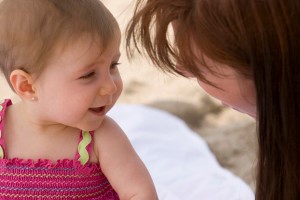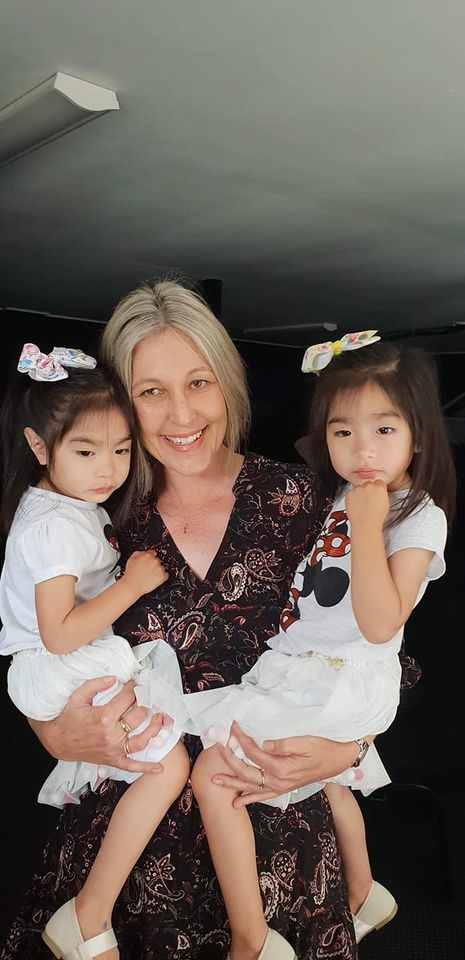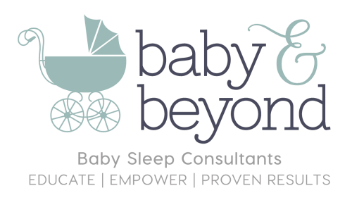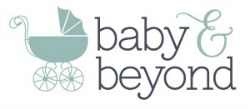Babies – Bonding & Brain Development

I recently saw this picture and it really captured my heart and reminded me of all those warm fuzzies of love and connection with our babies. This got me thinking about eye contact and how beneficial it is for both babies and parents.
A baby’s first milestone is to make eye contact. It is not just that your baby is learning to recognise you when you make eye contact with him or her. Your baby gathers information, responds to voices and people, and gradually begins to comprehend things as a result of this.
Let’s learn more about baby’s vision development:
First months.
A new-born can only see far enough to connect with the face of the person holding them – and they usually start making eye contact around 1 month old. However six to eight weeks is normal too!
It turns out that new-borns see mostly in black and white. This is due to the fact that the colour cells at the back of the eyes are not fully developed at birth. You may be wondering, “When do babies see colour?” Your baby can detect the brightness and intensity of colours at about 1 month, and by 3 months, your baby can actually begin to see several basic colours, including red.
A young baby needs to be calm and alert to hold eye contact, so don’t try to check this milestone while your little one is hungry, distressed, or tired. It is normal for a baby’s eyes to wander or move randomly during the first couple months of life because they are learning how to use their eyes together.
By 3 Months Old…
Baby will begin to focus on faces and close objects. They will also begin to follow moving objects with their eyes and may even reach out to swipe or touch the object as they develop their hand-eye coordination.1 By 4 months old baby will be able to see a full range of colours.
Around 7 Months Old…
Baby’s vision will be fully mature. During this time, baby will be able to follow faster movements with their eyes. Baby may also show more interest in toys with complex patterns and shapes. As baby grows, they will become more comfortable using their vision to explore their surroundings. Point out and name objects as your baby sees them to help baby make the connection between objects and their names.
Benefits of Eye contact
Researchers discovered that your baby’s brain is especially stimulated in the visual area. They’ve also found that babies enjoy looking at the faces of caring adults. Making eye contact with your baby on a regular basis promotes their brain development. According to a University of Cambridge study, eye contact syncs your brainwaves with the baby and assists in the development of their learning and communication skills.
Eye contact allows your baby to develop a sense of self before he or she can speak. Sense of self refers to who you are, how you distinguish yourself from others, what you like, and so on. All activities and skills become easier and more fluent when people have a strong sense of self. Looking into the eye’s releases oxytocin, which strengthens the bond between you and your little one. It also makes your baby feel more secure and it gives parents and family members all the warm fuzzies too.
Eye contact is easy to do
Basic
- Hold your baby in a comfortable position
- Smile at your baby while he or she is looking at you
- Maintain eye contact until your baby looks away.
- Allow time for your baby to come back to your eye contact.
- Smile again at your baby and wait for their response.
Advanced
- If your baby is already looking in your direction, make gestures, sing or talk to your baby. Nursery Rhymes can be useful here.
- Touch or voice along with mutual eye contact helps in developing better bonding with the baby.
- Keep attractive toys at a distance within the baby’s reach and encourage them to look at it.
- Keep talking to your baby while feeding. The sound of your voice can trigger the attempt at eye contact.
- If your baby is looking at an adult or object, pointing to the object and naming it helps in language development.

Eye contact while feeding your baby
Breastfed and bottle-fed babies benefit from eye contact during feeding.
Your baby may close his or her eyes or look away for a few moments during the feeding and then back to you again.
Phones, phones, phones- it’s about finding a good balance. Of course, sitting and feeding is an excellent time to catch up on messages and adult communication; even mindless scrolling can feel like “me time” for a parent when they are unable to get out and connect with friends as frequently as they used to.
Consider what time of day and which feeds the phone can be put down or left in another room so that you have some focused feeds throughout the day and really use the time to engage with your baby.


Compiled by Janferie Dewar – Baby & Beyond Sleep Consultant, Registered Nurse and Breastfeeding Educator

